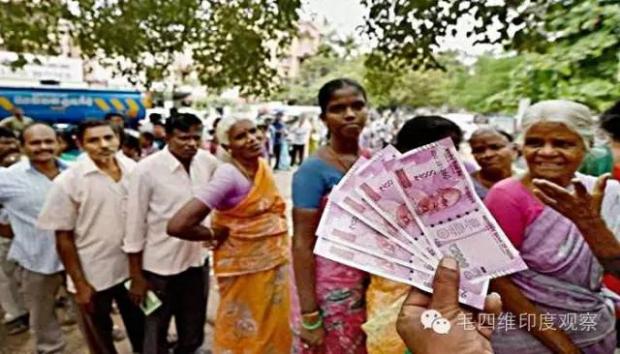阅读:0
听报道
11月8日晚,印度总理莫迪发表其上任以来第一次全国电视讲话,宣布一项令全国震惊的重大决定:500卢比(相当于人民币50元)和1000卢比面值的纸币从当天午夜起停止流通;同时发行新版500和2000卢比的纸币;旧币在12月31日之前可在银行储存或兑换新币。总理解释说,此举是为了打击腐败、地下经济以及恐怖主义。
印度经济严重依赖现金,而500卢比和1000卢比是两款最大面值的纸币,占货币流通总量的86%,因此,此举对印度经济和百姓生活来说,真可谓是晴天霹雳。连日来,全国到处是在银行门外和取款机前大排长龙的乱象。11月18日,印度最高法院警告政府:形势恶化可能导致骚乱!
20日,印度英文大报《印度快报》发表反对党国大党领袖人物、前财政部长P奇丹巴兰姆的文章,对莫迪的“货币新政”进行了全面梳理和批判。由于作者身份特殊,掌握内情,文章用数字说话,威而不怒,对读者理解印度当前的“货币危机”很有帮助。现将该文全文照译,以供感兴趣者参考。
替换货币还是抹黑现金?
P 奇丹巴兰姆
《印度快报》,2016年11月20日
因为人民仍在艰难困苦之中,我不得不回到“旧币换新”这个话题上来。现在,事情已经很清楚,这个废除500和1000卢比纸币的决定,构想是荒谬的,准备是糟糕的,执行是灾难性的。已有消息传出,当然是私下说的,除总理之外,参与决策的不超出四人,而政府首席经济顾问竟然不在这四个人之中!
可怕的结果
请看一片乱象:
1. 流通中的86%的货币被一举禁止,使千百万人事实上手中无钱。无钱买牛奶或药品,无钱支付三轮车或出租车,无钱购买蔬菜或粮食。我知道有个人,一整天没吃饭,就因为没有一个摊档接受500卢比的钞票。
2. 全国有13.4万家银行网点,再加上21.5万台取款机(其中40%有故障),假设每家银行营业点和每台取款机前平均有500人在排队,那全国每天就有1.1亿人、每人花数小时在排队换钱。其中大多数是有工作的人。计算一下,这对生产和经济带来多大的影响。
3. 出于没有明说的原因,合作银行不允许兑换货币。千百万农民无法储存或提取货币,而且,正值播种时节,他们没钱购买种子和化肥,无法雇佣劳工。
4. 批发市场关门。每周的集市停业。零售商店生意惨淡。
5. 诸如蒂鲁布尔、苏拉特、伊切尔格伦吉等工业中心的生产完全停顿,因为没钱向工人支付工资,没钱支付运输等服务费用。
6. 全国大约33%的被雇佣人员是临时工(估计达1.5亿人),他们突然失去工作,因为他们的雇主无法找到钱来支付工资。
7. 掮客和投机者纷纷涌现,他们兜售兑换旧币的黑市交易。一些游闲男女替人站队换钱,以赚取费用。诚实的人们转向不良分子以获得新币。政府采取措施,在换钱人的手指上涂上抹不掉的墨水记号,以防有人反复排队。要是再加上一台投票机,那就把每个银行网点和取款机都变成投票站了!
无知的吹嘘
这样的痛苦和混乱还将继续下去,因为印刷220亿张新钞以完全替换旧币,需要几个月的时间;并因为银行人手有限,取款机数量也有限(还需要调试)。与此同时,政府的吹嘘将会破灭:
引入新钞将结束腐败?当然不可能。受贿者将接受新钞。已有报道,在古吉拉特邦,康德拉港务局的两名官员受贿被捕,因为接受124张2000卢比的新钞!
将消灭假币?当然不可能。只要有人能印出含有新防伪技术的钞票,就会有人设法复制这样的技术。在世界上,防伪性能最好的货币就是美元。打击假币的最好方法是,定期推出新币以替换旧币,并总是领先一步。我们最近一次替换旧币是在2014年1月。
将堵塞产生黑线的渠道?当然不可能。有些行业喜欢使用来路不明的金钱(如批发、建筑、首饰、高教、选举赞助等),它们仍将我行我素,提供黑钱的渠道仍然会畅通。
没有一个主要的经济体能彻底避免地下经济,或称之为“影子经济”。根据世界银行的研究,影子经济在美国占GDP的8.6%(约为1.6万亿美元),在中国为12.7%(约为1.4万亿美元),在日本为11%(约为4800亿美元)。印度的影子经济估计为5000亿美元(占总量为2.25万亿美元GDP的22.2%)。这个数字是很大,但并非独特,而且近来还有规模在缩小的好消息。在巴西、俄罗斯和南非,影子经济规模更大;而以色列和比利时也好不到哪里去。
抹黑现金
总理似乎在倡导非现金经济的概念,并决心要打一场废除现金的战争。他的支持者说这是“外科手术式打击”。但他们不了解的是,印度人大量的现金交易是合法的,是有多种原因的,而且,现金交易将长期继续下去。我在这里与大家分享一个重要数据:作为一个有13.3亿人口的大国,在零售行业,全国只有146万台刷卡机!现金数码化将是一个漫长的过程。乌里袭击案之后的“外科手术式打击”(最近印方越过克什米尔控制线对巴方一侧进行的军事打击——译注)的目的是要结束越界渗透,但实际上越界渗透却增加了三倍之多(政府对此是承认的)。
对货币的“外科手术式打击”使千百万民众苦不堪言,使许多行业的运行戛然而止。我战栗地思忖:下一个“外科手术式打击”将是什么,可怕的结果又将是什么样的。
欢迎转发!欢迎订阅!
Demonetising notes or demonising cash?
Written by P Chidambaram | Published: November 20, 2016 12:15 am
I am obliged to return to the subject of ‘Old Notes for New’ because the hardship and suffering of the people continue. It is now clear that the decision to demonetise notes of Rs 500 and Rs 1,000 was ill-conceived, the preparation was terrible and the implementation was horrible. It has also emerged, through whispers of course, that besides the Prime Minister no more than four officials were in the loop, and the Chief Economic Adviser was not among the four!
Horrendous consequences
Look at the disruption:
1. About 86 per cent of the currency in circulation was declared ‘illegal tender’ in one fell swoop, leaving practically no money with millions of people. There was no money to buy milk or medicines, pay for an auto or taxi, or buy vegetables or grain. I know people who went without a meal for a whole day because no eatery would accept a Rs 500 note.
2. There are 1,34,000 branches of banks in the country. Add 2,15,000 ATMs of which about 40 per cent were working. Assuming that 500 persons, on average, stood in line outside each branch or ATM, every day more than 11 crore people spent hours standing in a queue to exchange notes. Most of them were working people. Calculate the impact on production and productivity.
3. For some inexplicable reason, cooperative banks were not allowed to exchange the notes. Millions of farmers could not deposit or withdraw money and, in the sowing season, there was no money to buy seeds or fertilisers or hire labour.
4. Wholesale markets shut down. Weekly fairs stopped. Retail outlets reported a calamitous fall in sales.
5. Industrial hubs such as Tiruppur, Surat, Ichalkaranji etc ground to a halt because there was no money to pay wages to the workers and no money to pay for ancillary and support services like transport.
6. About 33 per cent of all employed persons are casual labourers (estimated at 15 crore). Suddenly, they found themselves without work because those who employed them could not find the money to pay wages.
7. Brokers and touts sprung up offering to exchange the ‘demonetised’ notes for a price. Men and women, without regular work, offered to stand in line to exchange notes for a fee. Honest people turned dishonest to get some money. The government’s response was to use indelible ink to mark the finger. It could have added a voting machine and converted each bank branch and ATM into a polling station!
Ignorant boasts
The pain and suffering will continue because it will take months to print 2,200 crore notes of the new series to replace the old series and because of the limitations of bank staff and the ATMs (yet to be recalibrated). Meanwhile, the boasts of the government will unravel:
WILL DEMONETISATION END BRIBERY? Of course, not. Those who will take bribes will take them in the new notes. A case of bribery was reported from Gujarat where two officials of the Kandla Port Trust were caught receiving 124 notes of Rs 2,000!
WILL IT STOP COUNTERFEITING? Of course, not. If one human can print notes with new security features, another human can find a way to copy those features. The most counterfeited currency in the world is the US dollar. One way to combat counterfeiting is to phase out, periodically, old series of notes and introduce new series and try to stay one step ahead. The last time we did that was in January 2014.
WILL IT PLUG GENERATION OF BLACK MONEY? Of course, not. Sectors which are prone to use unaccounted money (wholesale trade, construction, jewellery, higher education, election funding etc) will continue to demand unaccounted money and, therefore, ways will be found to supply unaccounted money.
No major economy is entirely free from the scourge of a black or shadow economy. According to a World Bank study, the shadow economy in the US is 8.6 per cent of GDP (or about USD1,600 billion); in China 12.7 per cent (about USD 1,400 billion); and in Japan 11 per cent (about USD 480 billion). India’s shadow economy is estimated to be USD 500 billion (22.2 per cent of its GDP of USD 2,250 billion). It is large, but not unusual, and the good news is that its size is shrinking. Brazil, Russia and South Africa have larger shadow economies; Israel and Belgium are comparable.
Demonising cash
The Prime Minister seems to have bought the idea of a cashless economy and decided to wage a war on cash. His supporters called it a ‘surgical strike’, little realising that the bulk of the money transactions of the people of India are legitimate and in cash — and will be in cash for a long time — for many reasons. Let me share one crucial data point: for 133 crore people, at the retail level, there are only 14,60,000 Points of Sale (POS)! Cash to digital is a long journey. The ‘surgical strike’ post-Uri was intended to put an end to infiltrations, but the reality is that there has been a three-fold jump in infiltrations (as admitted by the government).
The ‘surgical strike’ on currency has resulted in the immiserisation of millions of people and bringing many sectors of the economy to a grinding halt. I shudder to think what the next ‘surgical strike’ will be and what dreadful consequences that will bring.
话题:
0
推荐
财新博客版权声明:财新博客所发布文章及图片之版权属博主本人及/或相关权利人所有,未经博主及/或相关权利人单独授权,任何网站、平面媒体不得予以转载。财新网对相关媒体的网站信息内容转载授权并不包括财新博客的文章及图片。博客文章均为作者个人观点,不代表财新网的立场和观点。




 京公网安备 11010502034662号
京公网安备 11010502034662号 